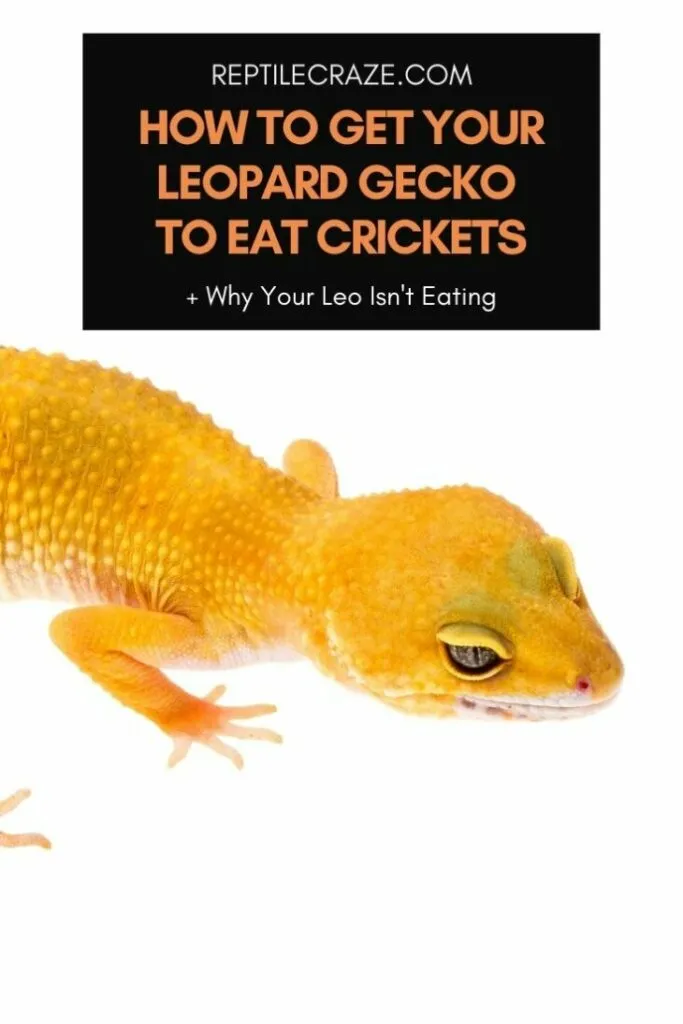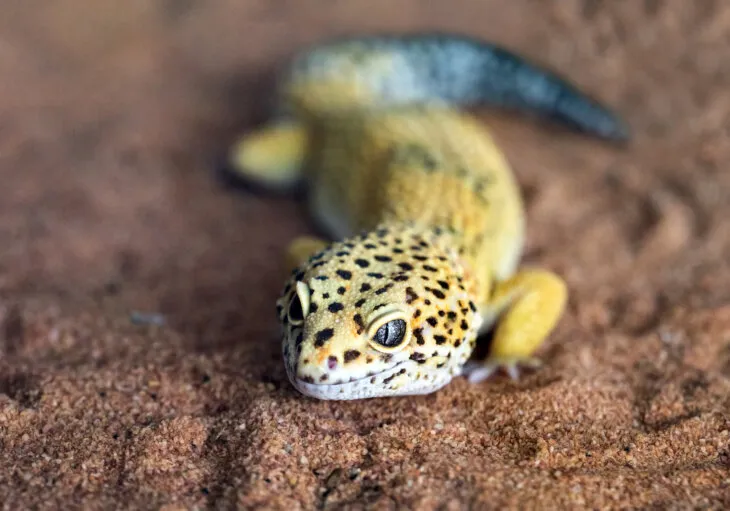
Leopard geckos keep their wild hunting instincts even as a household pet. They are insectivores, and one of their staple foods is crickets. But maybe you tried offering crickets to them, but they just turned away. Are they sick, or is your pet trying to tell you that you’re doing something wrong? How do you get your leo to eat crickets?
If a leopard gecko is refusing to eat crickets, you need to check the crickets, which should be alive, dusted, and the right size and type. You also need to check the
In this article, we’ll talk through tips on feeding crickets to leopard geckos and how you can get a reluctant gecko to feed on crickets.
Table of Contents
Getting a Leopard Gecko to Eat Crickets
If your leopard gecko has a good appetite for other
Note: If you want to know the specific reasons why leopard geckos stop eating crickets, read our article here!
Get those crickets moving
Don’t feed immobile or preserved crickets to your gecko. Being visual predators, there’s no incentive for the creature to eat them since it doesn’t have to ‘catch’ them. Make sure the insects are alive and moving when you put them into your gecko’s habitat.
Here’s a leopard gecko demonstrating how they hunt prey around a
Select the right size crickets
Your leopard gecko needs
Larger and more mature geckos can take bigger prey, but it should still be a size that could fit between your geckos’ eyes. Try smaller prey and work up to the bigger meals.
Make sure they’re the right type of cricket
There are many species of crickets, and not all of them are suitable as
Avoid feeding your leo with crickets you just caught in your backyard unless you have bred them yourself and know exactly what they eat: they could transmit parasites to your leopard gecko.
Feed at dawn or dusk
Because leopard geckos are most active in the dark, they might refuse to eat crickets you’re offering in the middle of the day.
Try feeding them during their natural hunting time, during the wee hours of the morning or early evening when the sky starts to dim.
Don’t offer too many crickets
Leopard geckos lose interest once they’ve satisfied their hunger, usually around 10-20 minutes of feeding time. They’ll ignore the rest of the creatures you put in their habitats.
Instead of letting the crickets hop around in there and irritate your pet, pull them out. They may nibble your gecko’s feet when it is asleep, which could cause serious injury.
We explain what crickets can actually do to your leopard gecko in this article (read it here).
Is your gecko addicted to something else?
Have you been feeding your gecko butterworms or waxworms? You might want to hit pause on that.
Those insects, which have a high fat content, are the cake of the reptile world. That means they’re good for using as treats and special surprises only.
You can learn more about feeding a leopard gecko with a waxworm addiction here!
Check your Leopard Gecko’s Environment
If your leopard gecko is still not eating their crickets, it’s possible that their environment is the problem.
It’s just too cold
Remember, leopard geckos are cold-blooded reptiles. That means that the speed of their digestion is based on the temperature of their surroundings.
If your leopard gecko’s
Make sure your
Or too dry
Just like with temperature, leopard geckos are dependent on their surroundings for the condition of their skin. If it’s not humid enough in the
If you need to add some moisture, take a spray bottle and mist the gecko’s vivarium. Just don’t make it too damp. They don’t like that, either.
Something else is wrong in the tank
One of the things that can prevent your leo from hunting is a lack of hiding places in the vivarium or your gecko not liking the substrate at the bottom. If the substrate is moldy or hurts your pet, they won’t hunt on it.

Get a Check-up on your Leopard Gecko’s Health
Leos may be physically challenged or something is internally wrong, which can make them stop eating. Watch out for these symptoms and consult an experienced reptile veterinarian if you have any concerns about your leo’s health.
Your gecko simply can’t see the bugs
If your critter has eyesight issues, it can’t see the bugs to hunt. This can happen if it hasn’t had a complete shedding or if it’s getting up there in age.
If a vet decides that’s the case, they may recommend you feed mealworms instead of crickets to your leopard gecko.
Or they can’t digest them
Crickets are quite easy to digest (as we explain here) but if your leopard gecko has an impaction, it won’t be able to digest its
There are plenty of reasons for this condition, including an inappropriate substrate in the
If you suspect your leopard gecko has an impaction, you should consult your veterinarian.
Or they are shedding
When geckos are shedding, something that happens roughly every six(ish) weeks, they probably won’t eat. Your pet has likely eaten its shed skin to make up for the nutrients expended during this high-calorie process.
Sometimes, it’s just brumation
Brumation is a process very similar to a bear’s hibernation. During this time, typically in the winter months, your leopard gecko will often be still and refuse
Otherwise, going to the vet is the key
There are other conditions that can affect a leopard gecko’s appetite, and if you’ve exhausted this list with no success, then getting a check-up at the vet is the next step.
For example, leopard geckos in captivity have a penchant for getting parasites, specifically pinworms. This is an uncomfortable condition that can cause a lack of appetite in your pet.
A veterinarian can prescribe the proper treatment to clear this up.
Conclusion
There are plenty of things you can try if your leopard gecko isn’t interested in crickets.
Make sure you’re serving the reptile active, fast-moving specimens in the appropriate amount, and limit butterworm and mealworm intake.
Check that the temperature and humidity in the vivarium are appropriate.
If your leopard gecko is still refusing crickets, take your pet to the vet for a check-up, which will help determine if parasites or brumation could be affecting its appetite.
- Enchi Ball Python: A Unique and Stunning Morph of Python regius - March 27, 2025
- Emerald Tree Monitor: The Enigmatic Green Guardian of the Rainforest - March 26, 2025
- The Egyptian Cobra (Naja haje): A Fascinating Serpent - March 25, 2025
